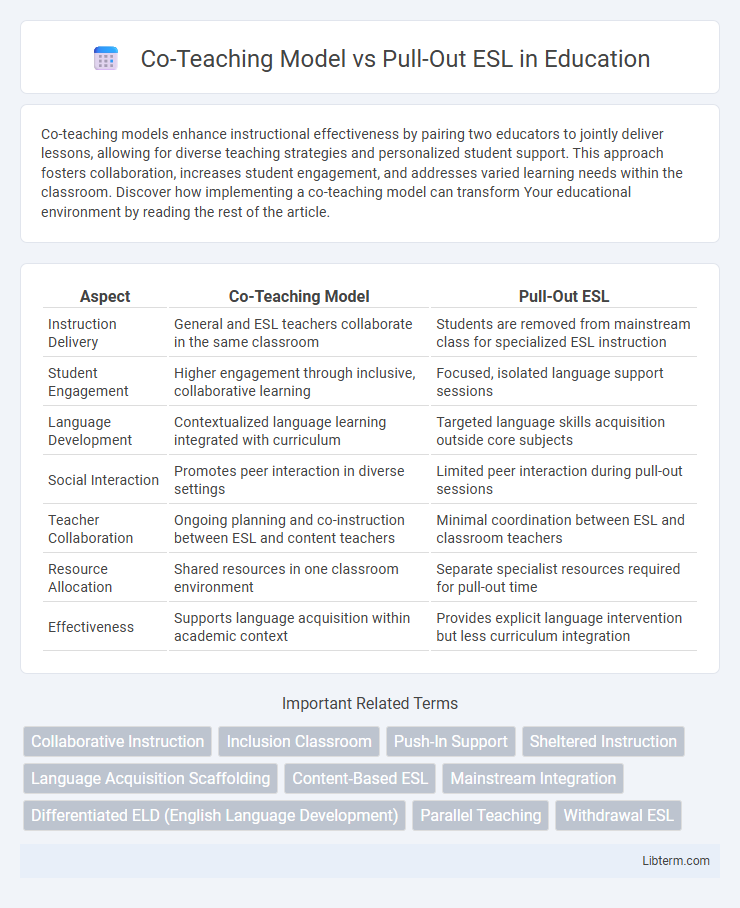Co-teaching models enhance instructional effectiveness by pairing two educators to jointly deliver lessons, allowing for diverse teaching strategies and personalized student support. This approach fosters collaboration, increases student engagement, and addresses varied learning needs within the classroom. Discover how implementing a co-teaching model can transform Your educational environment by reading the rest of the article.
Table of Comparison
| Aspect | Co-Teaching Model | Pull-Out ESL |
|---|---|---|
| Instruction Delivery | General and ESL teachers collaborate in the same classroom | Students are removed from mainstream class for specialized ESL instruction |
| Student Engagement | Higher engagement through inclusive, collaborative learning | Focused, isolated language support sessions |
| Language Development | Contextualized language learning integrated with curriculum | Targeted language skills acquisition outside core subjects |
| Social Interaction | Promotes peer interaction in diverse settings | Limited peer interaction during pull-out sessions |
| Teacher Collaboration | Ongoing planning and co-instruction between ESL and content teachers | Minimal coordination between ESL and classroom teachers |
| Resource Allocation | Shared resources in one classroom environment | Separate specialist resources required for pull-out time |
| Effectiveness | Supports language acquisition within academic context | Provides explicit language intervention but less curriculum integration |
Introduction to ESL Instructional Models
The Co-Teaching Model and Pull-Out ESL represent two foundational approaches in ESL instructional models, each with distinct advantages for English language learners. Co-Teaching involves collaboration between general and ESL teachers within the mainstream classroom, fostering inclusive environments and allowing real-time linguistic support. Pull-Out ESL offers targeted, individualized instruction outside the general classroom, emphasizing focused language acquisition but potentially limiting integration with grade-level content.
Overview of Co-Teaching Model
The Co-Teaching Model integrates ESL instructors within mainstream classrooms, promoting collaboration between general and ESL teachers to support English language learners (ELLs) in real-time. This approach enhances language acquisition through shared instructional strategies and differentiated support tailored to students' diverse needs. Research highlights increased engagement and academic achievement when ESL expertise is embedded directly in content instruction compared to separate Pull-Out ESL sessions.
Overview of Pull-Out ESL Model
The Pull-Out ESL model involves removing English Language Learners (ELLs) from their general education classrooms for specialized language instruction with certified ESL teachers. This targeted approach provides focused support on English language acquisition but often limits integration with grade-level content and peer interaction. The model is commonly used in schools with a diverse ELL population requiring individualized language development outside the mainstream classroom.
Key Differences Between Co-Teaching and Pull-Out
Co-Teaching Model integrates ESL teachers and general educators in the same classroom, promoting inclusive learning and immediate language support, while Pull-Out ESL removes students from the mainstream class for specialized language instruction, potentially interrupting social and academic continuity. Co-Teaching facilitates collaborative lesson planning and real-time scaffolding, whereas Pull-Out ESL targets focused language skill development but may limit exposure to grade-level content. Research shows Co-Teaching enhances engagement and academic achievement by providing contextualized and sustained language practice.
Benefits of Co-Teaching for English Learners
Co-Teaching Model enhances English learners' academic achievement by providing inclusive, real-time language support alongside grade-level instruction, fostering both content mastery and language development. This collaborative approach promotes differentiated instruction tailored to diverse learner needs, boosting student engagement and confidence within the mainstream classroom. In contrast to Pull-Out ESL, Co-Teaching minimizes missed instructional time and social isolation, resulting in higher language proficiency and better integration.
Advantages and Challenges of Pull-Out ESL
Pull-Out ESL programs allow for targeted language instruction by removing students from mainstream classrooms, enabling personalized support for English language learners (ELLs) to address specific linguistic needs and improve proficiency efficiently. However, this approach may lead to social isolation from peers, potential stigma, and missed content lessons during withdrawal periods, impacting the overall integration and academic progress of ELLs. Balancing focused language development with opportunities for inclusion remains a critical challenge in the effectiveness of Pull-Out ESL models.
Impact on Student Academic Achievement
The Co-Teaching Model enhances student academic achievement by providing consistent, collaborative instruction within the general education classroom, promoting language development alongside content mastery. Pull-Out ESL services, while offering targeted language support, may lead to fragmented learning experiences and less integration of content knowledge, potentially impacting overall academic progress. Research indicates that students in co-taught classrooms demonstrate higher proficiency gains and improved performance in core subjects compared to peers receiving pull-out ESL instruction.
Collaboration Between ESL and General Education Teachers
The Co-Teaching Model fosters continuous collaboration between ESL and general education teachers through shared planning, instruction, and assessment, enhancing language support within the mainstream classroom. In contrast, Pull-Out ESL limits teacher collaboration as students are removed for separate language instruction, reducing opportunities for coordinated strategies and real-time adjustment. Effective collaboration in co-teaching ensures integrated language development and content learning, leading to improved student outcomes.
Choosing the Right Model for Your School
Choosing the right ESL model depends on your school's specific goals, resources, and student needs. The Co-Teaching Model integrates ESL specialists and general education teachers in the classroom to provide simultaneous instruction, fostering collaboration and more inclusive language support. Pull-Out ESL, which separates students for targeted language instruction, can offer intensive focus but may disrupt mainstream class engagement and requires careful scheduling to optimize learning outcomes.
Conclusion: Best Practices for ESL Instruction
Co-teaching models foster inclusive classrooms by integrating ESL instruction directly with general education, promoting language development through collaborative strategies and real-time scaffolding. Pull-out ESL programs often isolate English learners, limiting exposure to grade-level content and peer interactions essential for academic language acquisition. Best practices for ESL instruction emphasize co-teaching approaches that combine content mastery with language support, ensuring equitable access and stronger academic outcomes for English learners.
Co-Teaching Model Infographic

 libterm.com
libterm.com